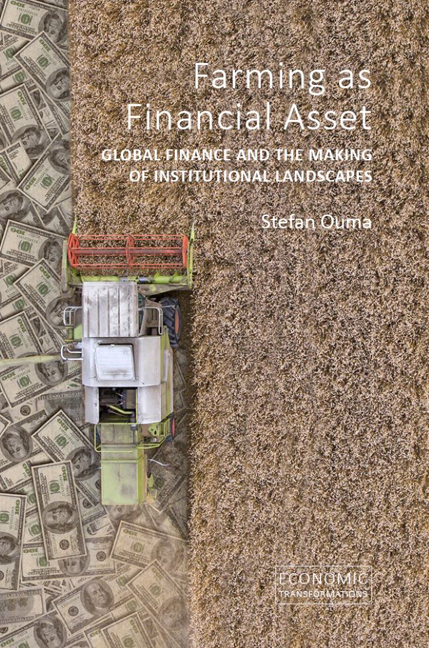Book contents
- Frontmatter
- Contents
- Preface
- Acknowledgements
- List of illustrations
- 1 Introduction
- 2 Optic: how do we study the finance– farming nexus?
- 3 History: how old is the finance– farming nexus?
- 4 Numbers: what we know (and do not know) about finance-gone-farming
- 5 States: how are foreign investments in farming regulated and accounted for?
- 6 Value(s): why has the road to “greener pastures” been so bumpy?
- 7 Delegation: what happens inside the agri-investment chain?
- 8 Grounding: what does assetization look like from below?
- 9 Radices: food futures, with or without finance as we know it?
- Epilogue
- References
- Index
7 - Delegation: what happens inside the agri-investment chain?
- Frontmatter
- Contents
- Preface
- Acknowledgements
- List of illustrations
- 1 Introduction
- 2 Optic: how do we study the finance– farming nexus?
- 3 History: how old is the finance– farming nexus?
- 4 Numbers: what we know (and do not know) about finance-gone-farming
- 5 States: how are foreign investments in farming regulated and accounted for?
- 6 Value(s): why has the road to “greener pastures” been so bumpy?
- 7 Delegation: what happens inside the agri-investment chain?
- 8 Grounding: what does assetization look like from below?
- 9 Radices: food futures, with or without finance as we know it?
- Epilogue
- References
- Index
Summary
Somewhere in a pension fund office in central Europe in 2008 an external consultant presented Mr B with an opportunity he could not turn down. The world had just been shaken by the subprime crisis, threatening the entire global financial system. This was a unique situation, as it “simultaneously involved problems in money, credit, banking, property, equities, and sovereign and corporate bonds” (Arjalies et al. 2017: 121). With a real estate investment crisis quickly turning into a sovereign debt crisis across Europe, one of the mainstays of institutional investors – fixed income (e.g. from government bonds) – was at particular risk, threatening to compromise the ability of large financial institutions to service their future commitments. As liability-oriented asset managers,1 these needed to achieve a return of between 4 and 8 per cent on capital per annum to be able to pay future beneficiaries their promised yield. When governments, particularly in the United States and some European countries, not only bailed out banks too big to fail but also lowered interest rates through quantitative easing policies, the market was suddenly awash with “hot money” looking for greener pastures. Mr B's thought process was: “Why not invest in real greener pastures? After all, rich families in his country had invested in forests for centuries. Such investments may require you to lock in your capital for some time, but you will be compensated for the risk with a premium.” Mr B can clearly remember how the decision was made to turn to agriculture:
We saw we were running into problems on the fixed-income side. We had made the decision to start with agriculture in 2009, 2010, in Australia and Brazil. In the short term, after the financial crisis, opportunities arose in that investment space, especially in the corporate space. However, it was already clear that this would not last for long. The fact that these interest rate reduction trends would continue and that at some point we would have also fallen below the actuarial interest rate, which at that time was still at 4 per cent across all our investments. And, for us, the topic of real assets coupled with perhaps the second label, liquidity and liquidity premium, came in very early on.
- Type
- Chapter
- Information
- Farming as Financial AssetGlobal Finance and the Making of Institutional Landscapes, pp. 111 - 136Publisher: Agenda PublishingPrint publication year: 2020



